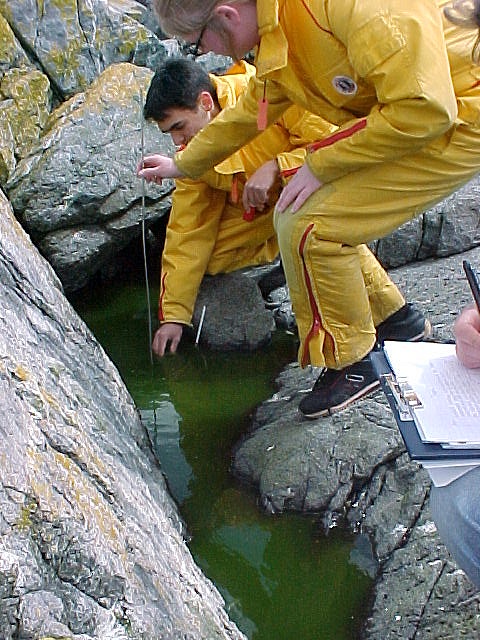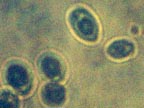| Lab on Primary Productivity of Pyramimonas See the video on a discussion of the high tidepools and productivity |
||||||||||
|
|
 Background: (adapted from Vernier lab 23 of “Biology with Computers”) Background: (adapted from Vernier lab 23 of “Biology with Computers”)
Oxygen is vital to life. In the atmosphere, oxygen comprises over 20% of the available gases. In aquatic ecosystems, however, oxygen is scarce. To be useful to aquatic organisms, oxygen must be in the form of molecular oxygen, O2. The concentration of oxygen in water can be affected by many physical and biological factors. Respiration by plants and animals reduces oxygen concentrations, while the photosynthetic activity of plants increases it. In photosynthesis, carbon is assimilated into the biosphere and oxygen is made available, as follows: 6 H2O + 6 CO2(g) + energy = C6H12O6 + 6O2(g) The rate of assimilation of carbon in water depends on the type and quantity of plants within the water. Primary productivity is the measure of this rate of carbon assimilation. As the above equation indicates, the production of oxygen can be used to monitor the primary productivity of an aquatic ecosystem. One method of measuring the production of oxygen is the light and dark bottle method. In this method, a sample of water is placed into two bottles. One bottle is stored in the dark and the other in a lighted area. Only respiration can occur in the bottle stored in the dark. The decrease in dissolved oxygen (DO) in the dark bottle over time is a measure of the rate of respiration. Both photosynthesis and respiration can occur in the bottle exposed to light, however. The difference between the amount of oxygen produced through photosynthesis and that consumed through aerobic respiration is the net productivity. The difference in dissolved oxygen over time between the bottles stored in the light and in the dark is a measure of the total amount of oxygen produced by photosynthesis. The total amount of oxygen produced is called the gross productivity. The productivity of an upper tidepool at Race Rocks, as with many aquatic environments, varies seasonally throughout the year. Rain washes down nitrogen and phosphates into the tidepool and increases the productivity. In a lake or river, human activities, such as fertilization of fields and the operation of sewage treatment facilities, can alter the natural balance of nitrogen and phosphates in water. In this lab, you will first learn the technique of using the Oxygen Probe to measure the primary productivity of a seawater sample, and then you will proceed to devise an experiment to quantify net and gross productivity of microalgae from an upper shore tidepool when you have manipulated a specific factor that may affect photosynthesis. The identification and taxonomy of these organisms can be assisted by the internet site maintained at the University of Montreal by Charles O’Kelly. You should observe them under the microscope and describe their movements. See the Pyramimonas Index–U. of Montreal |
||||||||||||||||
|
|
|||||||||||||||||
| OBJECTIVES: In this experiment, you will 1. Use a dissolved oxygen probe to determine the level of dissolved oxygen in a sample of sea water.
2. Measure the rate of respiration in a water sample. 3. Measure the net and gross productivity in a water sample. 4.Design an experiment to compare the rate of productivity under two different environmental conditions. MATERIALS:
PROCEDURE: This first procedure will be a practice run so that you can understand how the equipment and data logger work. 1. Obtain a BOD bottle. 2. The dissolved oxygen probe requires a 10 minute period to polarize before it can be used. Be sure it has warmed up sufficiently before use. 3. Prepare the computer for data collection by opening EXP23.LXP from the Biology with Computers experiment files. Load the calibration file EXP23.CLB. 4. Fill the BOD bottle with a sea-water sample from the jar provided. To fill a BOD bottle
5. Measure and record the temperature of the water sample . 6. Before using the Oxygen Probe, Calibrate it according to the special directions provided by the instructor. 7. Remove the Dissolved Oxygen Probe from the storage bottle. Place the probe into the BOD bottles so that it is submerged half the depth of the water. Gently and continuously move the probe up and down a distance of about 1 cm in the tube. This allows water to move past the probe’s tip. Note: Do not agitate the water, or oxygen from the atmosphere will mix into the water and cause erroneous readings. 8. After 30 seconds, or when the dissolved oxygen reading stabilizes, record the DO reading . 9. Now you are ready to design an experiment to test some variable that affects productivity. Processing the DATA 1. Determine the respiration rate. To do this, subtract the DO in BOD Bottle 1(the initial DO value) from that of BOD bottle 2 (the dark bottle’s DO value). 2. Determine the gross productivity in the BOD bottle. To do this, subtract the DO in the light bottle’s DO value from that of the dark test tube’s DO value. 3. Determine the net productivity in each BOD bottle. To do this, subtract the DO in the light bottle’s DO value from that of the initial DO value . THE PLAN FOR AN INVESTIGATION Now that you understand the basics of recording Oxygen levels with an Oxygen Probe, I expect you to come up with an appropriate controlled experiment for the green algal water from the high tidepools at Race Rocks. You will have two periods to plan what you want to do and to carry out the investigation. You will probably need some extra time as well since the minimum time for Oxygen generation is about an hour. Develop some hypotheses that you can then proceed to test using the technique. You must provide a written proposal for approval before starting the actual experiment. Be sure to have this checked and initialled by the teacher before proceeding with the investigation. Some broad hints and way-out ideas to consider: 1. There may be a connection between primary productivity and pH in a pond. See the video on the use of green ponds to provide sewage treatment. 2. Bottles of green algae hung at different levels in the ocean may provide different levels of productivity.( Or you may simulate this by different light intensities in the lab. 3.Turbidity or nutrient level may effect productivity. 4. Note the collection date of the green water sample on the storage jar: Fresh samples may differ in photosynthetic or respiration rates. 5. We have inorganic fertilizer available in the lab. 6. How much does temperature affect productivity and respiration? 7. From our preliminary measurements of the tidepools, we noticed that high salinity and low salinity were measured in pools that were clear or non-green on the upper intertidal. 8. The pools these samples come from are subjected to heavy rainfall at some times and salt water spray and even submersion at others. I wonder if the organisms and their ability to photosynthesize is affected? – right away— a half- hour later ?? 9. If you are going to take a sample, be sure it has been covered with the dark bag for several hours before sampling, as it does not take very much time to saturate the water with oxygen. 10. Be creative: think of all the implications of photosynthesis and take advantage of this opportunity to do a controlled experiment on a specific variable. 11. If you have a good reason to re-sample from the pools, we may even be able to arrange it! FOR FURTHER REFERENCE: |
|||||||||||||||||
